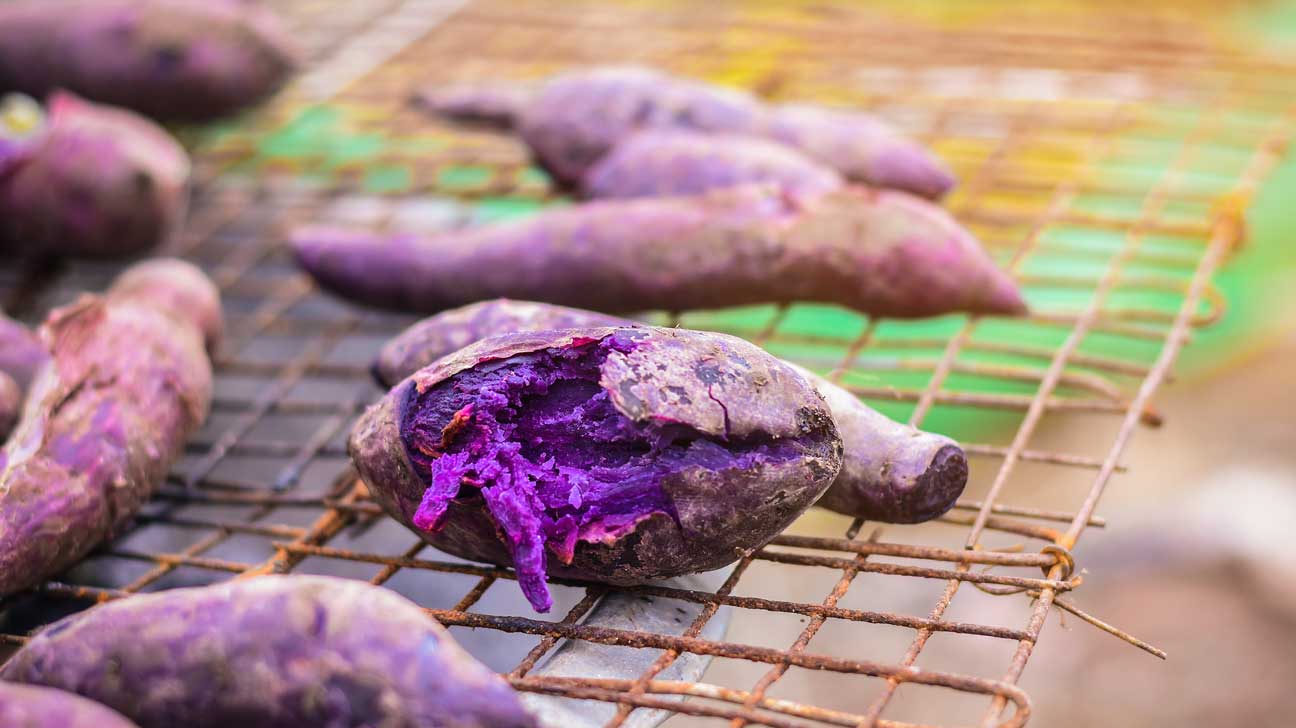
Purple yam, also known as ube, is a vibrant root vegetable that has captured the hearts and taste buds of many. But what makes this tuber so special? Purple yam isn't just a pretty face; it's packed with nutrients and has a rich history. Originating from Southeast Asia, this yam has found its way into various dishes, from desserts to savory meals. Its unique color comes from anthocyanins, which are antioxidants that offer health benefits. Curious about its uses, nutritional value, or cultural significance? Purple yam is more than just a food trend—it's a staple in many kitchens worldwide. Let's dive into 20 fascinating facts about this colorful tuber!
Key Takeaways:
- Purple yam, also known as ube, is a vibrant and nutritious root vegetable rich in antioxidants, vitamins, and minerals. It's used in both sweet and savory dishes, making it a versatile and valuable addition to any diet.
- Beyond its delicious flavor, purple yam offers numerous health benefits, including supporting heart health, boosting the immune system, improving eye health, and promoting healthy skin. It's not just a tasty ingredient – it's a powerhouse of nutrients!
What is Purple Yam?
Purple yam, also known as ube, is a tuber native to Southeast Asia. It’s famous for its vibrant purple color and sweet, nutty flavor. This versatile root vegetable is used in both savory and sweet dishes.
-
Purple yam is rich in antioxidants. The deep purple color comes from anthocyanins, which help fight free radicals in the body.
-
It’s a good source of vitamins. Purple yam contains vitamins A, C, and E, which are essential for maintaining healthy skin, vision, and immune function.
-
High in dietary fiber. This root vegetable helps improve digestion and can aid in weight management by making you feel fuller longer.
-
Contains essential minerals. Purple yam provides potassium, calcium, and iron, which are important for bone health, muscle function, and oxygen transport in the blood.
Culinary Uses of Purple Yam
Purple yam is a staple in many Asian cuisines. Its unique flavor and color make it a popular ingredient in various dishes.
-
Used in desserts. In the Philippines, ube is commonly used in sweets like ice cream, cakes, and pastries.
-
Can be made into jams. Ube halaya is a popular Filipino jam made from purple yam, sugar, and milk.
-
Added to savory dishes. In some cultures, purple yam is used in soups, stews, and even as a filling for dumplings.
-
Versatile in baking. Its natural sweetness and vibrant color make it a favorite for baking bread, muffins, and other baked goods.
Health Benefits of Purple Yam
Beyond its culinary uses, purple yam offers several health benefits that make it a valuable addition to your diet.
-
Supports heart health. The potassium in purple yam helps regulate blood pressure and maintain heart health.
-
Boosts immune system. The high vitamin C content strengthens the immune system and helps the body fight off infections.
-
Improves eye health. Vitamin A in purple yam is crucial for maintaining good vision and preventing eye diseases.
-
Promotes healthy skin. Vitamins E and C work together to protect the skin from damage and promote a youthful appearance.
Growing and Harvesting Purple Yam
Growing purple yam requires specific conditions, but it can be a rewarding experience for those interested in gardening.
-
Thrives in tropical climates. Purple yam grows best in warm, humid environments with plenty of rainfall.
-
Takes time to mature. It typically takes about 8 to 12 months for purple yam to fully mature and be ready for harvest.
-
Requires well-drained soil. Proper drainage is essential to prevent the tubers from rotting in the ground.
-
Can be propagated from cuttings. Purple yam can be grown from vine cuttings, making it easier to propagate than some other root vegetables.
Cultural Significance of Purple Yam
Purple yam holds cultural importance in various regions, particularly in Southeast Asia.
-
Symbol of prosperity. In the Philippines, ube is often associated with good fortune and is a popular ingredient during festive celebrations.
-
Used in traditional medicine. In some cultures, purple yam is believed to have medicinal properties and is used to treat various ailments.
-
Part of folklore. Stories and legends in Southeast Asia often feature purple yam, highlighting its significance in local traditions.
-
Celebrated in festivals. Some regions hold festivals dedicated to purple yam, showcasing its culinary and cultural importance.
Purple Yam's Fascinating World
Purple yams aren't just pretty to look at. They're packed with nutrients like vitamins A and C, fiber, and antioxidants. These tubers can boost your immune system, improve digestion, and even help with blood sugar control. Plus, they add a unique flavor and vibrant color to dishes, making meals more exciting.
From traditional desserts in the Philippines to trendy health foods in the West, purple yams have found their way into kitchens worldwide. Their versatility means you can enjoy them in sweet or savory dishes, baked, boiled, or even mashed.
Next time you're at the grocery store, grab a few purple yams. Experiment with new recipes and enjoy the health benefits they offer. These colorful tubers are more than just a pretty face; they're a delicious and nutritious addition to any diet.
Frequently Asked Questions
Was this page helpful?
Our commitment to delivering trustworthy and engaging content is at the heart of what we do. Each fact on our site is contributed by real users like you, bringing a wealth of diverse insights and information. To ensure the highest standards of accuracy and reliability, our dedicated editors meticulously review each submission. This process guarantees that the facts we share are not only fascinating but also credible. Trust in our commitment to quality and authenticity as you explore and learn with us.


